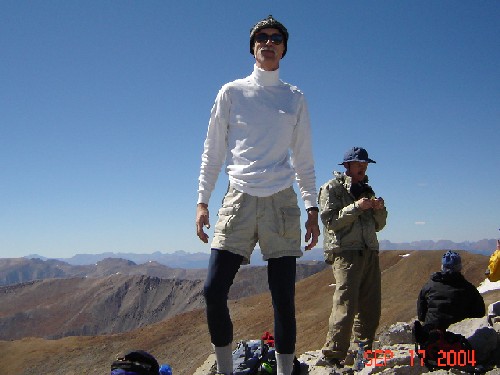4 Nov., 2007: With the weather holding amazingly mild, and only one day completely off from work this week, I was determined to make the most of it. I decided to try a brace of 10ers and 9ers accessible off of Gold Camp Road southwest of town.
My first objective was just west of the El Paso/Teller County line: a peak, unnamed on the USGS quad, at 10,490 ft., with the unofficial name of "Knights Peak." I started from the road where it makes a big southern loop just east of Rosemount Reservoir. My intention was to hike south up a drainage (where the map showed a faint trail) to the saddle between Knights and McKinley Pk. I ended up, instead, going mainly up the north slopes of Knights, navigating totally blind through the timber to the summit.
When I got to the rocky outcrop of the summit, I found an official CMC register bolted to the highest boulder. It had been placed in the summer of 2004, and bore only about 120 names, many of them repeats. (See photo.) Most significant were Mike Garratt, from November of 2005, and my buddy Kevin Baker, from March of this year. (His comment was "postholing test.") This was my highest point for the day.
After about 20 minutes on the summit, I headed down and east to the saddle, on my way to McKinley Peak. At that point, this was the highest ranked summit I had left in El Paso County, at 10,460 ft.
Following the ridge down and then up, it didn't take long to climb McKinley. But I was seriously in doubt as to which point was the true summit. The eastern point was clearly a little higher--in fact, considerably higher than the altitude noted on the topo map for McKinley--but the western point matched the accepted longitude and latitude for the summit more closely. Needless to say, I climbed both, so I can reliably say that I have scaled this peak! I took pictures, and left a register, on the western peak.
After that, I descended back to the saddle, and dropped off on the north side to get back to the road. I never did find the trail shown on the map, so I came out on the road an eighth of a mile or so east of my car, and had to hike back to it on the road.
I then set off to the east for my third 10er of the day. This was 10,100D, the line parent of Cheyenne Mountain. I found the "trailhead," a Forest Service cabin just west of the shooting range, and parked at a wide spot in the road just to the west of it. There is a clear trail that leads north up a shallow drainage to a broad saddle east of the peak. From there, I headed east up to a false summit, from which I could get a decent view of the remaining climb. The final approach is, again, just a bushwhack through the trees, up the south side of the summit. Views to the east are pretty good, but those to the west are largely blocked by trees. It was interesting to look down on St. Peters Dome; from here, both the actual summit and the more challenging eastern point can be seen. It was still before 2pm when I got to the summit, and I quickly headed down to pursue my two 9ers.
I backtracked west on the road for a fraction of a mile, and quickly found the large rock cairn which marks the start of the trail to Devils Slide (9,900 ft.). The well-marked trail leads north and then north east up to the ridge in back of this summit. From there, it's just a short hike to the south to the base of the impressive rock wall leading to the summit. This would prove to be the most challenging climbing I did all day. In fact, from a distance, it looks almost unclimbable. But from closer up, it becomes clear that a broad gully splits the wall and, while it is steep, it is a fairly easy Class 3 scramble. Fifty feet or so of this nifty climbing leads to the surprising large and flat summit area, which offers great views all around. I took some pictures, and quickly returned to the trailhead, and set off east for my final peak of the day.
This was Sugarloaf Mtn. E (9,663 ft.) just east of Bear Trap Ranch. The trail begins just inside the entrance to the ranch, on the access road on the south side of Gold Camp Rd. A clear trail switchbacks up the north face of the mountain, and I made the climb in just 13 minutes. I found a large windbreak, built of available wood, protecting the flat spot just east of the summit rocks; clearly, it had been used as a campsite many times. From the summit, a good view can be had to the west.
Five and a quarter hours after I first started hiking, I got back to the car and headed home, with five new summits bagged on an amazingly warm November day.
Photos are at:
http://picasaweb.google.com/tcogwr/FiveLocalPeaks
Long life and many peaks!



0 Comments:
Post a Comment
<< Home